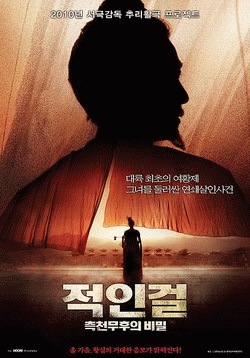
DETECTIVE DEE AND THE MYSTERY OF THE PHANTOM FLAME
(DI RENJIE)
China, 2010, 127 minutes, Colour.
Andy Lau, Karina Lau, Bing Bing Li, Chao Deng, Tony Leung, Ka Fai.
Directed by Tsui Hark.
Tsui Hark was one of the veterans of the Hong Kong group of directors, like John Woo and Johnnie To, who directed classic martial arts films. He also went to the US to direct Jean- Claude Van Damme. With the incorporation of Hong Kong into China, including its film production, the directors have been able to find bigger budgets and broader stories.
This one sounds like a blend of Nero Wolfe and Hercule Poirot – in fact Dutch author, Robert van Gulik has written some Detective Dee mysteries, referring to the detective as Judge Dee. However, the setting is the Tang Dynasty, China in 689 AD, so not a simple or cosy mystery and detection.
In fact, the film, based on a Chinese tale of Dee, is very spectacular, re-creating the empire in lavish detail of costume, decor and courtly etiquette. A central location for much action is a 60 metre high statue of the Buddha in progress outside the palace. It is the interior of the statue, with extraordinary engineering devices, that is most impressive.
As with so many other historical epics from China, there is a great deal of martial arts fighting, swordplay and elegant leaping through the air a la Crouching Tiger.
On these levels, the film is worth seeing.
However, while showing foreign guests through the statue, a manager literally explodes. Not only whodunit, but how was it done? And there are several more such startling deaths.
The social situation is tense as the wife of the dead emperor, Wu, is about to be crowned as the first (and, in fact, the only) female emperor in Chinese history. She has killed or imprisoned many of her enemies. However, she entrusts the investigation of the murders to an imprisoned rebel, the detective Dee.
We can enjoy Dee’s pursuit of the solution to the crimes and, eventually, he and we realise who the murderer must be. In the meantime, there are servants of the empress, a loyal woman servant and an albino soldier, stalking Dee. There is also a talking stag who utters oracles and a great deal of Chinese ritual.
Veteran Andy Lau portrays Dee.
Spectacular, stirring and entertainingly investigative.
1. A blend of spectacle, action, mystery, history? How well combined?
2. The entertainment value, for the Chinese audience, for world audiences?
3. The production values, sets, the statue of Buddha, the huge interiors, the engineering? Palace, temples, forests? The lavish atmosphere? The musical score?
4. The action, stunt work, choreography, battles, individual fights? Martial arts and swordplay, enormous leaps? The contribution of the action to the response? The musical score?
5. The information and introduction to the history, 689-690, the emperor, his death, Empress Wu, building the statue, preparing for her coronation, the first female emperor? Her plotting, the plots against her, the detection? The end, her coronation, 705 and her resigning, fulfilling her pledge to Detective Dee?
6. The statue, its size, the explanations of spirituality for its structure, the interiors, the work, engineering, the vastness? The foreign guest, the tour? The issue of the amulets? The sudden death, the explosion, interior? The reactions, the investigation? The supervisor, the amulets, his death? The mysterious flame?
7. Pei, albino, young and impetuous, his role for the empress, policing the situation? His abrasive personality? His confrontation with Shatuo? Suspicions? His contribution to the investigation, his theories, the water, drinking it, coming from outside? With the empress, with Shang-Guan? With Dee, his suspicions of Dee? Going into action, the visit to the widow, seeing the map of the column? His being captured, the chains, the fight, exposed to the sun, his explosive death? The button and the information for Dee?
8. Shang- Guan, her role, long loyalty to the empress, the empress’ protégée, serving her, absolute dedication, her role in the investigation, with Pei, with Dee? The transformation, the fight, in the forest, her death?
9. The mysterious deer, the voice? The ventriloquism? The chaplain, on the banner, the voice? The explanation of his role, serving the empress, killing her rivals? His disappearance? The mysterious deer, their attack – and Dee defending himself and killing them?
10. Shatuo, his hard work, the loss of his hand, imprisonment by the empress? His job of supervising the building, Dee as his long-time friend, his disappearance, his being the murderer? The motivation, his hand, the tube and the book, the amulets and the holes, pouring the molten metal to overturn the statue? Vengeance, the final fight, the confrontation with Dee, his death?
11. Dee, in prison, his wild look, the attacks, the old man? His history, his campaign against the empress, his motivation? Transformation in appearance? Arriving for the investigation, being entrusted to it by the empress? Shatuo and the explanations? Shatuo and the beetles? Visiting the Phantom City, the people there, the investigation? The mystery of the statue – the curve for it to fall on the coronation? The empress, the fights, Shang- Guan and the encounter, transformation of her face, the chaplain, her death? Seeing the blueprint, the confrontation of Shatuo? Diverting the statue’s direction of fall, saving people, saving the empress? His motivation for the people, the pledge by the empress? His being infected, going to the Phantom City?
12. The splendour of the court, Chinese pomp and circumstance, the buildings, the costumes? The etiquette and manners? Autocratic, rebellion, the military, the various squads, Shatuo and his men? Order, higher values than mere personal values?
13. This ancient tale, the role of the detective – and the parallel with detective stories like those of Sherlock Holmes? For a 21st century audience?